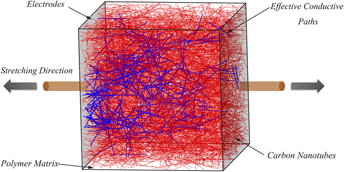Published online by Cambridge University Press: 04 September 2018

The elastic polymer composite embedded with carbon nanotubes (CNTs) is an ideal candidate for stretchable and flexible sensor fabrication due to the perfect combination between the excellent properties of CNTs and the high stretchability of the elastomer. A cube model of nanotube/polymer composite is constructed to comprehensively and theoretically analyze its electrical behavior, which is dominantly governed by the CNT network. The aspect ratio and alignment of CNTs significantly influence both the percolation threshold range and the electrical conductivity; however, the electrical conductivity of CNTs has little impact on the percolation threshold. The piezoresistivity of the composite is not only governed by the property of CNTs but also by the mechanical property of the polymer matrix, including the Poisson’s ratio and alignment of CNTs. The specific reasons why the composite resistance rises when it is stretched are investigated. Finally, one optimizing suggestion is given for making the CNTs/polymer composite with high sensitivity.